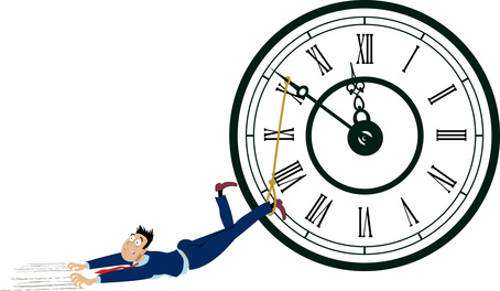Does this sound familiar to you?
You know you've got a big day ahead, so you had set your alarm for earlier than normal to really get cracking. After all, the early bird catches the worm, right?

You just want to get going, so you skip breakfast and surely that is saving you some time.
You do the same at lunch, or maybe just eat a quick meal at your desk, and plough on through.
Only…. The end of the day comes and you've jumped from job to job, never seeming to finish anything, and you finish the day disappointed. Disappointed in the results, which you thought would have been more substantial, and disappointed in yourself. Now you're thinking you may have to do this again tomorrow.
If this is you, you're not alone, you could be one of the millions of people that struggle to manage their time properly and be as productive as possible.
But fear not! Help is at hand!! You can turn this around by building a plan that will allow you to be more effective at time management, and correspondingly more productive.

Sounds great, doesn't it? Let's crack on with building that awesome plan!
How to Build Your Plan
Have you already got a plan? Not a problem! It's likely that if you've read this far, that plan's not as effective as you want it to be. So it's time for one of two things, a small scale adjustment, or a redesign from scratch!
Here are the building blocks for either approach.
Step 1: Plan Your Time
Do you know when you're at your best, and most productive? And I DO mean productive! You get people that they say work best in the mornings, or that they're night owls, but that may just be their preference, or even a bad habit.
Consider the person that has a bad habit of going to bed too late, which means they wake up exhausted, and find that their mornings are a complete disaster.
That doesn't mean that they cannot be productive in the morning, all it requires is some self-discipline at bed time.
Another example is a person that routinely eats a massive meal for lunch, which leaves them all lethargic between lunch and the end of the afternoon.
Again, a change of routine could shake up that person's idea of personal productivity.
So look at when you could be your most productive, and plan accordingly. Not just your work activities, but the other activities that impact your energy levels.
Run before work, instead of after work, to get your blood pumping and endorphins flowing! Boost that serotonin level! Those kinds of changes can affect your whole outlook on when you are at your most productive!
Then, once you've done that, plan the most important tasks, or the ones that require the most concentration, for when you're at your best. After all, if you fail to plan, you plan to fail!
Step 2: Create a To-Do List
"Begin each day as if it were on purpose." Regardless of what you think of the movie Hitch (I personally love it!), this is a great line!
It speaks of starting the day with intent. The best way to do that is to either create a to-do list first thing, or simply be able to get cracking on the one created the evening or night before.

Include everything in your list, and allocate a priority for each. That will allow you to create a schedule.
Now, depending on if you're like me and still paper-based, or really tech-savvie and using different kinds of apps, find how best this works for you.
You may create a new list on paper (and there are even pre-designed pads for that), or you can use the calendar feature of Outlook (possibly the world's most under-utilised application, or use mobile apps such as Workflowy (my colleague uses that), it doesn't matter, just use one!
Step 3: Create a Schedule for the Day
Now that you've created your list, take a look at the tasks on your list and start creating a daily plan.
Depending on the type of activities you have, look at how long tasks normally take, and it might be possible to create a schedule with half hour or hour long slots. You don't have to schedule everything down to the last minute, but it's useful to have slots that can then become routine.
If most of your days are similar, you can then extrapolate that out to a weekly schedule.
Step 4: Remember to Factor in Weekly and Monthly Tasks
When you're planning your daily tasks, remember to include those equally important weekly and monthly tasks that also have to be completed. You may do a big grocery shop on a specific day of the week, or have to drop and collect children at specific activities.
Fit these into your weekly schedule and give yourself enough time to complete them in case there are any last minute problems or changes.
If you are using apps or other kinds of tech, you are usually able to programme in repetitive tasks, at a certain time on a given day. That makes it way easier.
Step 5: Schedule in Breaks
It's vital to schedule breaks into your routine. Research shows that people who take regular breaks are more productive than those who attempt to power through without stopping for any kind of break.
However, it's up to you whether you favor one or two longer breaks or a few short ones. Find out what works best for you – but take time out, even if it's just to make a cup of tea.
This will allow you to recharge and get you in the right state of mind to fully concentrate on work again.
If you're office bound, and spending a lot of your day sitting down, you must use breaks to stand up and move around. Getting the blood flowing will increase your energy levels.
The longer you stay seated, the worse it is!
Step 6: Exercise
Not only is exercise vital for health reasons, but it's proven to boost brainpower, sharpen your memory, reduce stress and alleviate anxiety. Research shows that workers who exercise on a regular basis are more productive.

The
Mayo Clinic recommends 150 minutes of moderate exercise (jogging, swimming, cycling) per week, or 75 minutes of vigorous exercise – this seems like a lot, but if you struggle to fit exercise into your leisure time, go for a brisk walk during your lunch break. Walk for 30 minutes Monday to Friday and that's your 150 minutes of exercise ticked off your to-do list!
If time really is limited, take the obvious route, 75 minutes of vigorous exercise, you get the same health benefits, at a cost of half the time.
And if you're really even thinking where you're going to get 75 minutes a week from, try HIIT. High-intensity interval training is meant to only be done for about 15 minutes a week, 2-3 times a week. Come on, you can fit that in!
For anybody working in latitudes that have excessively short days in winter, you may be travelling to and from work in the dark, and not seeing sunlight. It's possible to then suffer from SAD (Seasonal Affective Disorder).
Your body needs sunlight, so getting out to walk while on lunch may be the chance to get the 20 minutes at least of sunlight that you need each day. This will also then prevent drops in energy levels (or worse, depression!)

If you'd like to learn more about time management, why not take a look at how we can help?
Learn how to manage your time better with our online courses.
RRP from $89 – limited time offer just $12.99
Step 7: Eat Properly
Do you skip breakfast and grab a quick sandwich to eat at your desk most days? If so, you're not alone – but it's important that you give your body the
nutrients it needs to keep your productivity levels up during the day.
Brain-powering foods to include in your diet are fish, blueberries, avocado, dark chocolate, and whole grains.
Never skip breakfast! Countless studies show that breakfast eaters tend to have lower cholesterol, heart disease and blood pressure, and have the energy they need to power through the day!
Factor breakfast into your routine, and set aside time to prepare nutritious meals.
Similarly, it's too easy to say, "I'll work through lunch as I've so much to do." The rationale is that you save yourself up to an hour that can then be used for completing tasks.
Unfortunately, the drop in energy means that although you have more time, you are less productive within that time, and you haven't gained anything! In fact, you've probably set yourself up for a less than productive evening too.
Step 8: Factor in Distractions
Like most people on the planet, you're probably aware that social media and mobile phones are huge time wasters. You just mean to click on Twitter or Whatsapp for a quick catch-up – and an hour later, you're still there! Nooooooooo!!!!
Distractions like these can make it difficult to stick to your routine. You could try switching off your phone and there are apps you can use to limit your time on social media.
However, don't feel you have to shut yourself away from the world while you're working. Sometimes, it's more sensible simply to plan for these distractions and factor them into your day! Meet a friend for coffee and a quick catch up, or allocate yourself 10 minutes to check Facebook.
By factoring these distractions into your plan, you can limit the amount of time you waste on them.
With this, the two "Dis"s go together. If you are going to factor time in for distractions, then you do need to be disciplined, and not go over the allocated time.
Step 9: Use Technology to Help You
I've already mentioned technology and apps that are available. While some apps (particularly those for social media) can be distractions, used correctly, they are invaluable.
I've already mentioned
Workflowy, which can help you keep your idea and notes organized, tracking tasks, and bringing order to your day. Another to try is
Momento, a mobile app that encourages you to enter all your thoughts, ideas and distractions into the app, freeing your mind so you can focus on the task in hand.
Or find out what may be available for you wherever you are. Let me use the London Underground as an example. There are loads of apps available, but
Tube Exits tells you which coach to board that will be closest to your platform exit. Less fighting through crowds! Yay!
Time Planner is another personal productivity app designed specifically with time management in mind, helping you schedule tasks on a daily basis. Experiment and see what works best for you - just don't waste too much time on it as that would be counter-productive!
Step 10: Batch Process
Last but not least: Batching!
Batching is the single best time management tool I've ever learnt! Essentially, rather than flitter from task to task, getting pulled in all sorts of directions, plan to do similar things together.
Let me give a simple, yet obvious example. Your list includes a car journey to 4 different places, but with no specific times required for any.
So why get dressed to go out 4 separate times. Plan to go out once, and do all 4 jobs, going from one to the other. See, that was obvious. Now I'm sure that if you really look at your list of jobs, you'll see that there are other things you can batch too. Like make those 3 important phone calls, and so on.
I deliberately kept this till the end. A, because of how important it is. But B, it's a chance to go back to your plan, a little time after you've been away from it. Fresh eyes may give you more insight as to how to create that schedule.
Make it Work for You
My plan probably wouldn't suit you. Similarly, yours would not likely suit me. That's fine, just find what does work for you. Now, think about that time you tried cooking some new dish.
Did it work perfectly?
Probably not, but each time you tried it, the results got better, right? Even Michelin starred chefs have to trial and error new recipes before adding them to their menus.
The same applies to your plan, it may not be 100% successful first time out.
So tinker with it, just like you would a recipe. Add a bit of this, take away a bit of that, and soon you'll have a plan that works for you.
Stick to It
They say it takes 21 days to form a new habit. So creating your new plan is really part A. Part B is then making it a habit.
Set yourself a goal, just like with any other objective you have. I'm going to follow this new plan for 21 days, and at the end of that, I'm going to give myself a reward. Great, now you have an incentive to help you achieve that goal. You're well on your way!
Keep It Up
Backsliding is a word that has horrible connotations. You're sliding back into your old ways!
You've rewarded yourself for getting to 21 days and making it a habit, now you cannot risk backsliding.
I had a Jamaican chicken dish that it took me quite a few attempts at following the recipe to get to the point that I was really good at it. I then got complacent.
I invited guests over again, and because I knew that I had now done it so well a few times in a row, attempted to just go from memory, and not actually open the recipe and follow that.
So, it wasn't a disaster, but I let myself down. The small amount of pineapple I left out was the sugar that was meant to balance out the savory. My guests didn't know, but I did!
My lesson: keep using the recipe book! And that's my final advice, create your plan, stick with it till it becomes a habit, and then keep it up, don't allow yourself to backslide!

If you'd like to learn more about time management, why not take a look at how we can help?
Learn how to manage your time better with our online courses.
RRP from $89 – limited time offer just $12.99
 You just want to get going, so you skip breakfast and surely that is saving you some time.
You just want to get going, so you skip breakfast and surely that is saving you some time. Sounds great, doesn't it? Let's crack on with building that awesome plan!
Sounds great, doesn't it? Let's crack on with building that awesome plan! Include everything in your list, and allocate a priority for each. That will allow you to create a schedule.
Include everything in your list, and allocate a priority for each. That will allow you to create a schedule. However, it's up to you whether you favor one or two longer breaks or a few short ones. Find out what works best for you – but take time out, even if it's just to make a cup of tea.
However, it's up to you whether you favor one or two longer breaks or a few short ones. Find out what works best for you – but take time out, even if it's just to make a cup of tea. The Mayo Clinic recommends 150 minutes of moderate exercise (jogging, swimming, cycling) per week, or 75 minutes of vigorous exercise – this seems like a lot, but if you struggle to fit exercise into your leisure time, go for a brisk walk during your lunch break. Walk for 30 minutes Monday to Friday and that's your 150 minutes of exercise ticked off your to-do list!
The Mayo Clinic recommends 150 minutes of moderate exercise (jogging, swimming, cycling) per week, or 75 minutes of vigorous exercise – this seems like a lot, but if you struggle to fit exercise into your leisure time, go for a brisk walk during your lunch break. Walk for 30 minutes Monday to Friday and that's your 150 minutes of exercise ticked off your to-do list!
 I've already mentioned Workflowy, which can help you keep your idea and notes organized, tracking tasks, and bringing order to your day. Another to try is Momento, a mobile app that encourages you to enter all your thoughts, ideas and distractions into the app, freeing your mind so you can focus on the task in hand.
I've already mentioned Workflowy, which can help you keep your idea and notes organized, tracking tasks, and bringing order to your day. Another to try is Momento, a mobile app that encourages you to enter all your thoughts, ideas and distractions into the app, freeing your mind so you can focus on the task in hand.
























